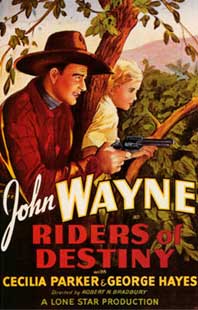 With his white horse, cowboy hat, guitar, & a couple pisspoor tinpan alley tunes instead of the preferable folk ballads or western swing, John Wayne does his stint as a singing cowboy. Singin' Sandy Saunders by name, unlike other singing cowboys, the Duke has to lip sync someone who can hold a note. With his white horse, cowboy hat, guitar, & a couple pisspoor tinpan alley tunes instead of the preferable folk ballads or western swing, John Wayne does his stint as a singing cowboy. Singin' Sandy Saunders by name, unlike other singing cowboys, the Duke has to lip sync someone who can hold a note.
The singer we're really hearing in this one is Bill Bradbury, the director's son, who, if he had any singing talent, couldn't prove it with these bad Billy Barber ditties. And when it comes time for Singin' Sandy to take a tripwire dive on his horse, the breakable guitar has conveniently slipped into the Phantom Zone until it's needed for a second ditty.
Finishing his first song on horseback in the opening segment, Singin' Sandy immediately finds an elderly white-haired sheriff (Lafe McKee) shot in the back, & begins to nurse him. The old sheriff then vanishes from the story until the end, but Sandy rides off toward the temporarily sheriffless town, saving gorgeous blonde cowgirl Fay (Cecilia Parker) along the road, who had gotten her horse shot out from under her while posing as a bandit.
There follows plenty of chasin' & ridin' & shootin', a bit of lassoin', & comic relief from goofy bad guys Bert & Elmer (Al "Fuzzy" St. John & Heinie Conklin), who serve chief baddy Kincaid (Forrest Taylor).
Kincaid is trying to force local ranchers to sell out for one dollar per acre, & as he owns water rights for the whole valley, he may have them cornered. He's additionally the secret head of the stage robber gang. The reason cowgirl Fay was posing as a robber was so she could steal a shipment of funds that belonged to her daddy ("Gabby" Hayes in an early role when he was still billed as George) before the bad guys stole it further along the stage route.
It's the usual B western doings & the only thing special about it is seeing that John Wayne even as a yunker in a $10,000 kiddy-flick has genuine screen presence, even if he couldn't sing the ill-advised non-western tunes himself. He takes on the standard-issue bad guys & quite naturally wins, but with slightly less reliance on violence.
Not that there's any shortage of violence, but resolving the ranchers' dilemma requires cleverness, geological knowledge, & the legal system. When Wayne does his trademark shit-in-his-pants walk down mainstreet in the fast-draw sequence against the hired gun (Yakima Canutt), he shoots twice, once each through the gunslinger's wrists, in order to cripple him for life instead of killing him outright. Which is a mite creepier than the scriptwriter likely intended.
There's a very nicely staged "runaway water wagon" scene in which the Duke's stunt double jumps from white horse to wagon team then drops down underneath the stomping hooves. It was a standard "gag" in these old westerns to stop a runaway coach or wagon, but all these decades later it's still pretty thrilling, & the stunt is real, unlike so many computer-created action scenes in today's adventure films.
This often-used stunt was performed by Yakima Canutt (who is also the gunslinger Slip Morgan), & just about every time you see it done in any film (most famously in Stagecoach, 1939), it's actually "Yak."
[SPOILER ALERT!] Another standard stunt is riding a horse off a cliff & plunging into a river. This too is a standard stunt for B westerns, but this time it's given an ironic plot context, since the bad guy drowns in the very water he tried to deny the rachers. [SPOILER ALERT!]
This was Wayne's first picture for the "Lone Star Productions," a subsidiary of Monogram Pictures. He would make fifteen more, & they wouldn't get better as they went along. There actually seems to be an attempt to make the first one more than averagely worthwhile, though it's debatable whether it succeeds. I found it to be pretty good of kind at its scant 53 minutes running time.
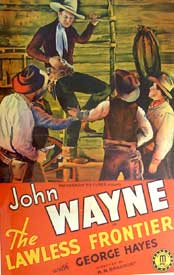 The vastly lower quality of Lawless Frontier (1934), even by poverty row film standards, is evident from the opening scenes which cuts between guys shooting out a cabin window in the darkest night, to cattle rustlers moving cows through brightest day not noticing to the gunshots, to some of the bad guys who seem to hear the gunshots & later begin to return fire. The vastly lower quality of Lawless Frontier (1934), even by poverty row film standards, is evident from the opening scenes which cuts between guys shooting out a cabin window in the darkest night, to cattle rustlers moving cows through brightest day not noticing to the gunshots, to some of the bad guys who seem to hear the gunshots & later begin to return fire.
It's like the various unrelated footages were spliced together from random left-overs off the cutting room floor of several other films, & a story-of-sorts retrospectively imposed on the results. Not until John Tobin (John Wayne) arrives home later that night & discovers his family killed can we guess the people shooting from the window were an innocent family robbed of their cattle, though the way it was edited it looked like the people in the cabin were shooting first, at mere cattlemen.
Tobin sets out in search of Pandro Zanti (Earl Dwire) the local bandito, for all appearances a stereotyped Mexican, though the script is twice careful to tell us he is half white & half Apache & only pretends to be Mexican. A strange insistency, & perhaps the earliest example of political correctness in western cinema, bending over backward to both have a bad-ass bandito character but not offend Mexican Americans who in the Southwest were sending their kids to the Saturday matinees in droves.
Zanti plans to kidnap Ruby (Sheila Terry) for his lusty needs. This is an unusual villainous trait for 1930s matinee westerns, aimed at young audiences who expected villains to be claim jumpers & killers, not rapists. Ruby & her daddy (George "Gabby" Hayes) hightail it out of there before she falls victim of the rapist-killer-but-not-a-Mexican, escaping by a clever ruse that almost gets Ruby drowned like a sack of kittens.
They run into Tobin tracking his family's killers, & whose stunt double does that standard stunt of horse & rider jumping into a lake, though Tobin's afterward perfectly dry. There was a convoluted bit in the middle of the film intended to get Tobin off his white horse & on a brown one, so that the horse-leap scene could be clipped from Riders of Destiny for insertion here. Tobin then saves the sack of Ruby & then they both dry off magically fast. Ruby, Dusty & Tobin thereafter join forces.
Sheriff Luke Williams (Jack Rockwell) is an ignorant ass who not only immediately takes credit for capturing Zanti when Tobin brings him in, but also arrests Tobin for the murder of Ruby's father Dusty who took a knife deep in the back & fell down dead. But Dusty will soon after, with wild disregard for probabilities, recover from death, claiming it was only a flesh wound, not even needing a bandaid or his shirt sewn.
The number of dumb things Sheriff Williams pulls are not worth cataloging at any length, but handcuffing a bad guy's boot to a bed, so that all he has to do is take off his boot to escape, seems dumbest of all, especially when Tobin made a point of telling Williams that Zanti can probably get loose.
[SPOILER ALERT] There's an oddly filmed chase scene across the desert partly on foot, Tobin after Zanti. The plot doesn't want Tobin to be portrayed as a killer, so the bad guy just happens on a desert watering hole clearly marked "Poison. Do not drink," drinks it anyway, & drops dead.
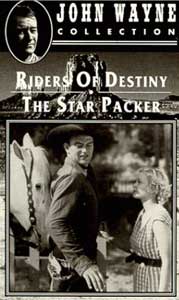 Strangely the film's not yet over, though the chief villain is now out of the picture. We're treated to plenty more hard ridin' & can't-hit-anything shootin', as Ruby & Tobin flee from Zanti's gang (among whom you'll spot the John Wayne film regular Yakima Canutt) & stupid sheriff alike. When the happy ending finally arrives, the happiest thing about it is there's a new sheriff, Tobin, an obvious improvement over halfwit Williams. [END SPOILER ALERT] Strangely the film's not yet over, though the chief villain is now out of the picture. We're treated to plenty more hard ridin' & can't-hit-anything shootin', as Ruby & Tobin flee from Zanti's gang (among whom you'll spot the John Wayne film regular Yakima Canutt) & stupid sheriff alike. When the happy ending finally arrives, the happiest thing about it is there's a new sheriff, Tobin, an obvious improvement over halfwit Williams. [END SPOILER ALERT]
Stunt man Yakima Canutt plays a bigger screen role than usual, as Yak, the Native American companion of U.S. Marshal John Travers (John Wayne), in the oddly titled B western The Star Packer (1934), horridly reminiscent of Fudge Packer, & can take a minute to realize it means "packing a marshall's badge." The oddness of the title got it renamed in Britain more comprehensibly as He Wore a Star.
Yak & Marshal Travers arrive as undercover agents to investigate the murders of sheriffs & a crime wave in Little Rock. With Yak's buckskins & feather, & Travers' white hat & white horse, they come off a bit like the Lone Ranger & Tonto. But in this case it would appear that the faithful Indian sidekick is himself an official government agent or deputy.
Yakima Canutt unlike Jay Silverheels as Tonto did not have even a jot of Indian blood, & looks in the main like what he is, a cowboy in an Indian outfit. Even so, it's nice to see an Indian character cast as a B western hero, indeed a fairly large co-starring role.
Although Yakima is named Yak in other Wayne pictures (& it was his actual nickname), he never again plays Yak the Indian sidekick, & his character roles tended to be quite small ones since he had also the duties of stunt coordinator, fight choreographer, stunt double, & frequently second unit director, making it hard for him to take on larger co-starring roles like this one, though the Duke hugely enjoyed working alongside his close friend.
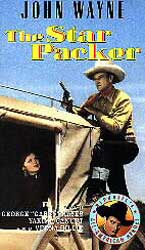 The Star Packer begins with the undercover US Marshal robbing a stage coach. This was to keep the actual stage robbers from getting the moneybag. Unfortunately, Travers disarmed the drivers' bodyguard, so a scene later, the driver & guard are murdered by disappointed highway robbers. The Star Packer begins with the undercover US Marshal robbing a stage coach. This was to keep the actual stage robbers from getting the moneybag. Unfortunately, Travers disarmed the drivers' bodyguard, so a scene later, the driver & guard are murdered by disappointed highway robbers.
The script does not question whether it might've been more heroic to protect human life than the moneybag, as B western morality often fails to penetrate its own cliches. Such films tend to repeat motifs with minor variations without actually thinking about them.
Some of the roughest bad guys in the west have gathered into a single gang which takes its orders over through a hole in a wall from the mysterious Shadow who nobody has actually seen. From a hollowed stump alongside mainstreet, the Shadow has murdered the new sheriff (Thomas G. Lingham) within minutes of the new man taking his oath, & no one can detect where the sniper shot from.
It's the second or third sheriff murdered in that town (the script contradicts itself on that point) & as that means nobody else wants the job, John Travers volunteers. So though nobody knows he's a goverment man, he does gain a local sheriff's authority, so that he & Yak can do their detectiving openly.
Young Anita Mattlock (Verna Hillie) has inherited her father's ranch, & arrives in Little Rock to be greeted by her uncle Matt Matlock (Gabby Hayes in a rare clean-shaven straight role) whom she had not previously met. This fraud actually murdered her father & uncle, & now wants to buy out Anita's ownership cheap, pretending he's doing her a favor.
Several tricks are played to frighten her in order to run the ranch herself. Her first inclination had been to sell the ranch, but when she realizes there are bad guys trying to scare her off, she decides to stay & fight, being rather spunkier than the fake uncle expected.
Why Anita never met her uncle before, & why he could pretend to be Matt Matlock & become head of the Cattleman's Union without any of the other locals noticing the identity swap, are just the most obvious of several lapses in logic & consistency in this hastily written & hastily filmed cheapy. It manages to entertain despite its problems, & makes up for its clunky story with some damned good action.
Travers & Yak find a tunnel system under the street which leads to the hollowed out stump in which the Shadow had his sniper's knot-hole view of the street. Travers instructs Yak how to rig up the stump as a trap for the bad guy.
When traps are sprung, & arrests start coming down, the Shadow knows it's only a matter of time before the trail leads to him. So he gets the remainder of his gang together for a raid on the town, with a machine-gun mounted on a wagon, intending to wipe out the entire town. B western villains had to be very clearly villains for the Saturday Matinee crowd of kids these hour-long cheapies were aimed at. But an intent to wipe out an entire town of its citizens would seem to be a new low.
Rarely are B westerns longer than about an hour, which is good, as they don't strain patience by not being good enough, & the stories sprint along with economy. The vast majority of the action is utterly cliche, but for the afficionado, it is possible to appreciate minor variations on motifs involving speeding wagons, hard riding, falling horses & riders, fistfights & shoot-outs.
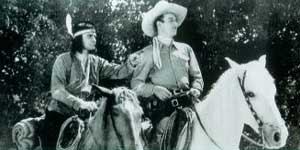 This time around we get a mass shoot-out on horseback with loads of horses & gunmen together with a machine gun on a speeding wagon & the heroine put on the wagon in harm's way. The good-guys instead of wearing white hats tie white towels around their heads so they won't accidentally shoot each other. These are significant variations indeed. This time around we get a mass shoot-out on horseback with loads of horses & gunmen together with a machine gun on a speeding wagon & the heroine put on the wagon in harm's way. The good-guys instead of wearing white hats tie white towels around their heads so they won't accidentally shoot each other. These are significant variations indeed.
There's a well done bit as the machine gun wagon crashes over a cliff with the chief bad guy (the Shadow/Uncle Matt) on board with Anita as hostage. All this amazing action, & then some, is extremely well done.
The young Wayne is a powerful screen presence even in these early years when he made only low budget films with poverty row director Robert Bradbury. Gene Autry's film's tended to be a lot better, & Autry's & Rogers' singing provided a fine bonus. But Wayne's early films, thanks to the fight choreography of Yakima Canutt, frequently had more realistic action. The action in The Star Packer is especially realistic when it comes to punches & falls.
There's no riding into the sunset & toward the next adventure for Marshal John Travers. After the extended action finale, there's a coda that picks up about six years later, when we discover that John has married Anita & are settled down in Little Rock. They have a young son (Davie Aldrich) who likes to dress up like an Indian to play with Yak.
copyright © by Paghat the Ratgirl
|
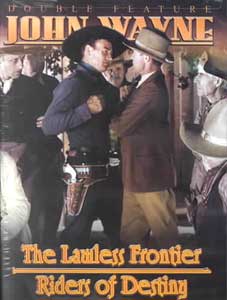


 Strangely the film's not yet over, though the chief villain is now out of the picture. We're treated to plenty more hard ridin' & can't-hit-anything shootin', as Ruby & Tobin flee from Zanti's gang (among whom you'll spot the John Wayne film regular Yakima Canutt) & stupid sheriff alike. When the happy ending finally arrives, the happiest thing about it is there's a new sheriff, Tobin, an obvious improvement over halfwit Williams. [
Strangely the film's not yet over, though the chief villain is now out of the picture. We're treated to plenty more hard ridin' & can't-hit-anything shootin', as Ruby & Tobin flee from Zanti's gang (among whom you'll spot the John Wayne film regular Yakima Canutt) & stupid sheriff alike. When the happy ending finally arrives, the happiest thing about it is there's a new sheriff, Tobin, an obvious improvement over halfwit Williams. [ The Star Packer begins with the undercover US Marshal robbing a stage coach. This was to keep the actual stage robbers from getting the moneybag. Unfortunately, Travers disarmed the drivers' bodyguard, so a scene later, the driver & guard are murdered by disappointed highway robbers.
The Star Packer begins with the undercover US Marshal robbing a stage coach. This was to keep the actual stage robbers from getting the moneybag. Unfortunately, Travers disarmed the drivers' bodyguard, so a scene later, the driver & guard are murdered by disappointed highway robbers. This time around we get a mass shoot-out on horseback with loads of horses & gunmen together with a machine gun on a speeding wagon & the heroine put on the wagon in harm's way. The good-guys instead of wearing white hats tie white towels around their heads so they won't accidentally shoot each other. These are significant variations indeed.
This time around we get a mass shoot-out on horseback with loads of horses & gunmen together with a machine gun on a speeding wagon & the heroine put on the wagon in harm's way. The good-guys instead of wearing white hats tie white towels around their heads so they won't accidentally shoot each other. These are significant variations indeed.